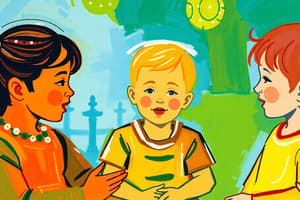Podcast
Questions and Answers
Which of the following best describes the primary focus of the textbook 'Becoming Speakers, Readers, and Writers'?
Which of the following best describes the primary focus of the textbook 'Becoming Speakers, Readers, and Writers'?
- The historical debates and research related to language acquisition in children.
- The development of articulation and speech production skills in children.
- Language as a tool for communication and enhancing children’s overall communicative competence. (correct)
- Specific language arts methods for teaching reading and writing to early childhood students.
Why is language considered essential to society, according to the text?
Why is language considered essential to society, according to the text?
- It is the foundation for perceptions, communications, and daily interactions, enabling us to represent and understand the world. (correct)
- It primarily serves as a tool for artistic expression and creative writing.
- It mainly facilitates economic transactions and international trade.
- It ensures the preservation of historical documents and literary works.
A child demonstrates competence in oral language but struggles to comprehend written instructions. According to the text, what key area needs further development?
A child demonstrates competence in oral language but struggles to comprehend written instructions. According to the text, what key area needs further development?
- Fluency in multiple languages.
- Competencies in using written language. (correct)
- Articulation and pronunciation abilities.
- Non-verbal communication skills.
In the context of early childhood language development, what does the textbook emphasize in relation to oral and written language?
In the context of early childhood language development, what does the textbook emphasize in relation to oral and written language?
A teacher wants to create an activity focusing on language competencies. Which activity aligns with the approach of 'Becoming Speakers, Readers, and Writers'?
A teacher wants to create an activity focusing on language competencies. Which activity aligns with the approach of 'Becoming Speakers, Readers, and Writers'?
How does the textbook define 'language'?
How does the textbook define 'language'?
Why do children need to develop a wide range of language competencies?
Why do children need to develop a wide range of language competencies?
If a child can speak fluently but struggles to understand the underlying meaning of conversations, which aspect of language competency needs improvement?
If a child can speak fluently but struggles to understand the underlying meaning of conversations, which aspect of language competency needs improvement?
A child demonstrates understanding when listening to a story. Which type of language competency is the child using?
A child demonstrates understanding when listening to a story. Which type of language competency is the child using?
Which statement accurately describes the relationship between receptive and expressive language development in children?
Which statement accurately describes the relationship between receptive and expressive language development in children?
A teacher observes a student struggling to pronounce certain words but having no trouble understanding complex instructions. Which area of language competency should the teacher focus on to support the student's development?
A teacher observes a student struggling to pronounce certain words but having no trouble understanding complex instructions. Which area of language competency should the teacher focus on to support the student's development?
According to the provided information, what is a key characteristic of language acquisition in early childhood?
According to the provided information, what is a key characteristic of language acquisition in early childhood?
In face-to-face communication, non-speech behaviors such as gestures and facial expressions can convey up to what percentage of information?
In face-to-face communication, non-speech behaviors such as gestures and facial expressions can convey up to what percentage of information?
Considering the information about language competencies, which teaching approach aligns best with supporting diverse learners?
Considering the information about language competencies, which teaching approach aligns best with supporting diverse learners?
A linguist is interested in understanding how cultural context influences the way people use language in different social settings. Which field of study would be most relevant to this research?
A linguist is interested in understanding how cultural context influences the way people use language in different social settings. Which field of study would be most relevant to this research?
A four-year-old is able to construct grammatically correct sentences and effectively communicate their needs, all without formal language lessons. Which concept best explains this ability?
A four-year-old is able to construct grammatically correct sentences and effectively communicate their needs, all without formal language lessons. Which concept best explains this ability?
Which activity would primarily develop a student's expressive written language skills?
Which activity would primarily develop a student's expressive written language skills?
Which of the following requires precise neuromuscular coordination in order to occur?
Which of the following requires precise neuromuscular coordination in order to occur?
Flashcards
Language Competencies
Language Competencies
Effective skills in speaking, listening, reading, and writing.
Language as Communication
Language as Communication
Communication using language, rather than just speech production.
Early Childhood Years
Early Childhood Years
The period from birth to age 8.
Interrelated Language Development
Interrelated Language Development
Signup and view all the flashcards
Language Defined
Language Defined
Signup and view all the flashcards
Range of Language Competencies
Range of Language Competencies
Signup and view all the flashcards
Oral Language
Oral Language
Signup and view all the flashcards
Written language
Written language
Signup and view all the flashcards
Receptive Language
Receptive Language
Signup and view all the flashcards
Expressive Language
Expressive Language
Signup and view all the flashcards
Psycholinguistics
Psycholinguistics
Signup and view all the flashcards
Sociolinguistics
Sociolinguistics
Signup and view all the flashcards
Speech
Speech
Signup and view all the flashcards
Phoneme
Phoneme
Signup and view all the flashcards
Communicative Competencies
Communicative Competencies
Signup and view all the flashcards
Non-Speech Behaviors
Non-Speech Behaviors
Signup and view all the flashcards
Language Acquisition
Language Acquisition
Signup and view all the flashcards
Study Notes
- Focus is on how children become effective communicators and how teachers can enhance their language development from birth through age 8.
- The text emphasizes language as a means of communication rather than speech production and articulation.
- Language is a system of symbols used to categorize, organize, and clarify thinking.
- Language is fundamental for representing and understanding the world and is essential for the existence of society and its culture.
Language Competencies for Children
- Children require a broad spectrum of language skills to function effectively in society and its various subcultures.
- Competencies encompass both oral and written language proficiency.
- Effective communication is needed across settings, including informal conversations, commercial interactions, media consumption, and professional or educational environments.
- Aims to enable participation in social events, occupational settings, and daily routines.
Communicative Competency
- Acknowledges the need to acquire diverse communication competencies.
- Competencies are vital for effectiveness across varied life settings.
- Encompasses both receptive and expressive language skills.
Receptive and Expressive Language
- Receptive language involves understanding oral and written communication.
- Expressive language involves producing language to communicate.
- Expressive language first develops orally through social interactions and the maturation of speech mechanisms.
- In literate societies, children also develop expressive written language by learning to use visual symbol systems like the English alphabet.
- Receptive language development precedes expressive language development.
- The relationship between receptive and expressive language development is dynamic and influenced by the child's developmental level, language knowledge, and learning environment.
Additional Key Points
- Children deduce the rules of their native language.
- Psycholinguistics studies how people acquire and process language.
- Sociolinguistics studies language, cultural, and situational influences.
- Language is a premier human achievement.
- Despite its complexity, 4-year-olds demonstrate well-developed communication skills.
- Language acquisition generally occurs without formal instruction.
- Linguists determine the language rules people use to communicate.
Speech
- Speech is a verbal means of communication requiring precise neuromuscular coordination.
- Spoken languages feature specific sounds, phonemes, and sound combinations.
- Components of speech include voice quality, intonation, and rate.
- Non-speech behaviors, such as gestures and facial expressions, can convey a significant portion of information during face-to-face communication (up to 60%).
Studying That Suits You
Use AI to generate personalized quizzes and flashcards to suit your learning preferences.




